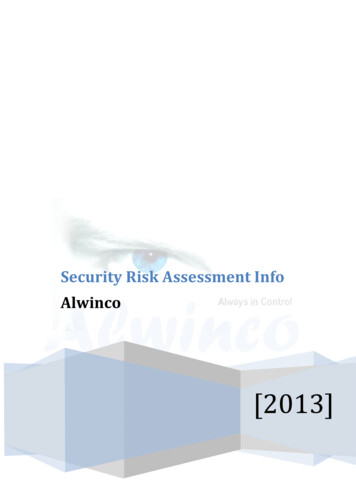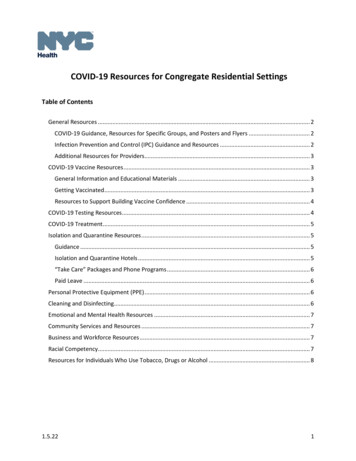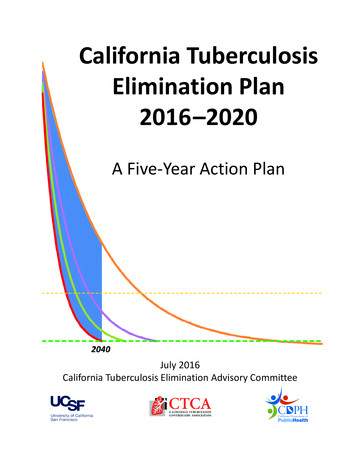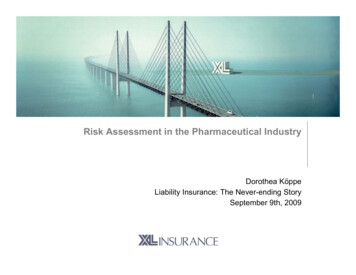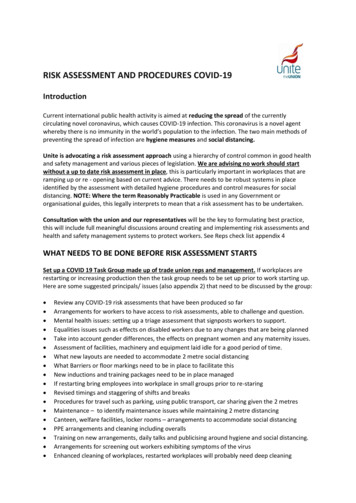
Transcription
RISK ASSESSMENT AND PROCEDURES COVID-19IntroductionCurrent international public health activity is aimed at reducing the spread of the currentlycirculating novel coronavirus, which causes COVID-19 infection. This coronavirus is a novel agentwhereby there is no immunity in the world’s population to the infection. The two main methods ofpreventing the spread of infection are hygiene measures and social distancing.Unite is advocating a risk assessment approach using a hierarchy of control common in good healthand safety management and various pieces of legislation. We are advising no work should startwithout a up to date risk assessment in place, this is particularly important in workplaces that areramping up or re - opening based on current advice. There needs to be robust systems in placeidentified by the assessment with detailed hygiene procedures and control measures for socialdistancing. NOTE: Where the term Reasonably Practicable is used in any Government ororganisational guides, this legally interprets to mean that a risk assessment has to be undertaken.Consultation with the union and our representatives will be the key to formulating best practice,this will include full meaningful discussions around creating and implementing risk assessments andhealth and safety management systems to protect workers. See Reps check list appendix 4WHAT NEEDS TO BE DONE BEFORE RISK ASSESSMENT STARTSSet up a COVID 19 Task Group made up of trade union reps and management. If workplaces arerestarting or increasing production then the task group needs to be set up prior to work starting up.Here are some suggested principals/ issues (also appendix 2) that need to be discussed by the group: Review any COVID-19 risk assessments that have been produced so farArrangements for workers to have access to risk assessments, able to challenge and question.Mental health issues: setting up a triage assessment that signposts workers to support.Equalities issues such as effects on disabled workers due to any changes that are being plannedTake into account gender differences, the effects on pregnant women and any maternity issues.Assessment of facilities, machinery and equipment laid idle for a good period of time.What new layouts are needed to accommodate 2 metre social distancingWhat Barriers or floor markings need to be in place to facilitate thisNew inductions and training packages need to be in place managedIf restarting bring employees into workplace in small groups prior to re-staringRevised timings and staggering of shifts and breaksProcedures for travel such as parking, using public transport, car sharing given the 2 metresMaintenance – to identify maintenance issues while maintaining 2 metre distancingCanteen, welfare facilities, locker rooms – arrangements to accommodate social distancingPPE arrangements and cleaning including overallsTraining on new arrangements, daily talks and publicising around hygiene and social distancing.Arrangements for screening out workers exhibiting symptoms of the virusEnhanced cleaning of workplaces, restarted workplaces will probably need deep cleaning
HOW IS THE VIRUS SPREAD/TRANSMISSIONIt is worth taking time to digest how this virus is transmitted, as this is very important inunderstanding what control measures need to be put in place to control the risks to workers.The World Health Organisation has identified that COVID-19 is not an airborne virus. Respiratoryinfections can be transmitted through droplets of different sizes. When the droplet particles areabove a certain size they are referred to as respiratory droplets, and when then are below a certainsize, they are referred to as droplet nuclei. According to current evidence, COVID-19 virus isprimarily transmitted between people through respiratory droplets and contact routes includingtouch points.What this means in practice is, the droplets are of a weight that they will fall to the ground at around1 metre, thus the 2 metre social distancing rule. They can remain on surfaces for some timedepending on type of material, see Government guide here https://www.gov.uk/governmentTherefore the two main methods of preventing the spread of infection being hygiene measures andsocial distancing. More information around hygiene and social distancing can be found on the UniteCOVID 19 web pages. Including information around mental health and legal advice on equalities.here: vid-19-advice/The Government advice on social distancing and other measures to workplaces and business iscontinually being challenged by Unite to ensure that workers remain safe, and is therefore an everevolving issue. Regularly updated here e-toemployers-and-businesses-about-covid-19.RISK ASSESSMENT PROCESS ndex.htmCheck list for risk assessment: Identify Hazard: Contraction of Covid-19 Infection * Stress connected to COVID 19 What workers will be harmed. How will they be exposed for example direct contact with droplets from an infectedperson or touching a person, surface or object which has the virus present? Rate the risk of infection occurring during undertaking the task, schedule, job etc. Select appropriate controls to protect workers using a hierarchy of controlExample:HazardContraction ofCovid-19Via persons orContact withobjectsRisk includingwho may beharmedUse of welfarefacilitiesMaintaining2 metreseparation &hygiene. All staffPre control RiskRatingSeverity xlikelihoodHigh or3 x 4 12See matrixbelowControlMeasuresIn brief forillustrationRestrict access.Barriers.Markings.Washing handsReg’ CleaningPost controlRisk ratingSeverity xlikelihoodLow or1x4 4See matrixbelow
MatrixLikelihoodSeverityNo injury or trivial(Minor injury) notime lostMinor injury (MI)lost time less thanthree daysSerious injury (SI)lost time greaterthan three daysMajor injury (MAI)lost time greaterthan seven daysAlmost certaindeath. Disablinginjury or fatality(DIF)Extremelyunlikelyto occurUnlikely122(U)Likely 10369121548121620510152025Example of written assessment:Hazard:Risk:Rating pre controlsRating after ControlsContraction of Covid-19 via contact person/objectsCarrying out tasks where working within 2 metersHighLowSuggested Controls Consider whether task needs to go head if not stop the job Limit task to small groups preferable two workers and short times Keep the same groups of workers together don’t interchange Ensure policy that workers with symptoms stay home is managed effectively Ensure PPE is worn throughout the task, select appropriate PPE for: RPE or masks, Nitrile gloves, glasses, disposable overall Arrange face fitting where needed and training in donning and doffing Supply washing facilities and/or sanitiser All cuts on the skin to be covered Contact points of equipment shall be cleaned down regularly Supply full method statement for each task and pre-start check list Have in place a procedure which allows workers to stop work if issues ariseHSE NI have a very good example of risk assessment and template for COVID 19Here: d-19-risk-assessment-templateHSE Examples sector risk assessments here https://www.hse.gov.uk/risk/casestudies/
HIERARCHY OF CONTROLSHierarchy of controls are an essential element within the risk assessment process, and is a feature inseveral pieces of legislation around risk assessment. In particular for COVID 19 the Management ofHealth and Safety at Work Regulations (MHSWR) and particular to biological hazards the Control ofSubstances Hazardous the Health Regulations (COSHH).The significance of this process is that employers need to follow a line of controls, which chooses themost effective and efficient method to prevent exposure and infection from COVID 19. Risks should bereduced by taking preventative measures in order of priority, employers should not just jump to theeasiest control measure to put in place. See below with some examples related to COVID 19.HSE Guidance on the hierarchy of risk controls NATIONInoculation when available, or immunity could be a way of eliminating harm from COVID 19,however it is not clear whether either would offer life time immunity. Some virus are knownto only accommodate several years’ immunity, and most viruses can mutate.Isolating people completely against exposure, is a way in which harm from the virus iseliminated. Examples of this are shielding where people are being advised to stay home for12 weeks, and working from home. Both prevent becoming infected and infecting others,care must be taken to ensure a safe working environment and assess mental health issues.Social distancing is an age old control, in the case of this particular virus which istransmitted in droplets which fall to the ground after a metre, maintaining a distance of 2metres apart will eliminate becoming infected through this transmission route. This controlneeds to be implemented stringently in order to be effective, together with good hygienepractices, both personal and in the workplace. See appendix 1 for hygiene controls.
SUBSTITUTION/REDUCTIONImportant example: Isolation of workers that become illEnsuring workers are not in work when ill is essential to reducing risk of transmission ofCOVID 19. One of the elements to achieving this is full sick pay from day 1, with informationto employees on symptoms and instruction to remain home no matter how mild thesymptoms. Confirmed cases of COVID 19 should initiate identifying close contacts,undertaking testing and isolation if test is positive. Organisations wishing to fulfil Goodpractice, would take this a step further and isolate close contacts until testing confirms oneway or another.Steps to support, social distancing and good hygiene need a collective approach as follows:ENGINEERING CONTROLSBarriers Place a physical barrier such as a Perspex screen, flexible polyethylene sheet, weldingblanket for example could be deployed to mitigate the potential for droplets reachingpersonnel working in proximity.These can be temporary or permanent, some screens can be deployed by pulling downfrom a roller, or clipped on The use of screens would need to consider factors including (but not limited to) fixingpoints, weight, wind direction, portability, access, fire risk and chemical incompatibilities.Any controls need to be risk assessed for the specific application. One of the most common problems is workers traveling in vehicles with more than oneperson, specialised companies are now undertaking barrier fixing in vehicles see picturebelow. Note: Social distancing of 2 meters needs to be undertaken in this situation, withbarriers as an additional supportive control measure or to avoid 2 metre breaches.
BARRIERS VEHICLESBARRIERSDemarcation lines 2mtres or more will assist the workers in keeping within socialdistancing requirements.Demarcation areas combined with physical barriers where they can be applied, is a goodcombination of controls when re enforced with appropriate messages and training.VentilationThis control needs to be professionally assessed, and will only work in specific areas. Whilstgood ventilation can assist in diluting particles is the air, there is not much evidence that itcan be relied on to prevent large droplets containing the virus reaching a worker. Thereforeit is advisable to deploy other measures set out below in conjunction with good ventilation.
ADMINISTRATIVE CONTROLS: SYSTEMS OF WORK AND PROCEDURESNote: The following measures will need to be applied collectively, together with engineeringcontrols when needed and PPE provision.Reducing time spent performing an activity Limit time in close proximity to other personnel to limit the potential risk, this will beto ensure PPE is not worn for extensive periodsA task which requires close proximity for multiple episodes of sustained time in ashift, consider a different pair/team for each episode which reduces contact.Consideration should be given to workforce planning to limit the potentialcontamination within the remaining workforce.Workforce planning Personnel could be paired or buddied to compartmentalise potential infection withinthe work teams. Consider segregating teams (i.e. Red & Blue teams) to maintain operational capacityif personnel become infected or enter into self-isolation. In the event that one person becomes symptomatic, placing their team-mate or pairinto isolation will be good practice for any responsible employer.Cleaning Undertake enhanced cleaning in line with Unite guidance such as touchpoints in thework area. Ensure that cleaning chemicals do not introduce a product safety hazard. Deep clean the workplace prior to ramping up production or reopeningPersonal Hygiene Maintain high levels of personal hygiene wash hands regularly for 20 seconds.Further info here vid-19-advice/Please refer to Appendix 1 for suggested list of Procedural Infection Controls
PERSONAL PROTECTIVE EQUIPMENT (PPE)PPE is acknowledged as being at the bottom of the hierarchy due to its inherent limitations. Inaddition current advice from all health authorities is that PPE should only be used in a health caresetting and within a narrow group of sectors, this may change and is a fluid situation. Please referto the Government PPE guidance hub to keep updated. Note there are gender differencesconnected to all PPE, this needs to be taken into account when selecting appropriate PPE.Respiratory Protective Equipment RPEHSE guidance document HSG53 states ‘when in an airborne state, micro-organisms can be classedas particles, so can usually be removed by filter-type Respiratory Protective Equipment (RPE). YouShould always use equipment fitted with the highest efficiency filter possible (protection factor ofat least 20) to control exposure down to the lowest levels.’ Therefore HSE recommends the use ofan FFP3 for use against viruses. HSE RPE guide: https://www.hse.gov.uk/pubns/books/hsg53.htmHSE advise that whilst FFP3 is the usual recommended control measure, if global supplies of FFP3masks are low during this pandemic. In this scenario, an FFP2 could be used as an alternative, asthis is consistent with WHO guidance. See here: quivalence-aprons-gown-eye-protection.pdfPLEASE NOTE The World Health Organisation has identified that COVID-19 is not an airborne virusand the risk comes from droplets, COVID 19 can become airborne when aerosol generatingprocedures (AGP) are being carried out in a clinical setting. It may be the case that a riskassessment identifies surgical masks as being sufficient. Unite recommends that due to thelimitations of surgical masks that they are only worn as communal protection. E.g. when workingin teams everyone must wear a surgical mask. Preference is fluid resistant type.Where the existing operational risk assessment requires RPE such as FFP2 or FFP3 respirator to beworn to protect against contaminants and particulates, this must be adhered to regardless of levelof protection offered for COVID 19.FFP RespiratorsHSE web page on RPE here: pment/
FFP respirators are indicated above, the first being the relatively short use disposable type FFP2/3 with theothers having filter cartridges fitted and all should be correctly face fitted. Particle filters will be markedwith a ‘P’ sign and filtration efficiency number, 1, 2 or 3. Particle filters should be changed frequently,probably daily or after the equivalent of a daily shift.TO KNOW CHECK LIST FFP2 and FFP3 provide a higher level of protection than is required for low-risk communitysettings. N95 is a north American standard and equivalent to FFP2 Should be face fit tested to ensure an appropriate protection factor is achieved Will not be effective when worn with facial hair compromising the facial seal FFP2 and FFP3 respirators are used in clinical settings by medical personnel in close contactwith known COVID-19 cases Can be worn for the duration of a shift – comfortable for approximately an hour betweenrest breaks The use of FFP2/P3 respirators should be prioritised for work where an aerosol orparticulate is generated and RPE is required as per the COSHH risk assessmentSurgical MasksA surgical mask is a loose-fitting, disposable device that is intended to be worn to catch themicroorganisms shed in liquid drops and aerosols from the wearer's mouth and nose . Fluidresistant type IIR, BS EN 46838 offers better protection to the wearer, as they are designed toprovide a barrier to the user from fluid contamination such as droplets and blood.TO KNOW CHECK LIST FRSMs can inhibit the spread of the virus by preventing the wearer’s bodily fluids fromentering the air around them when they cough, they also provide some limited protectionto the wearer from others who may cough in close proximity. FRSMs are effective only when used in combination with frequent hand cleaning with soapand water or sanitiser meeting testing standard to kill SARS COV-2 virus. Before putting on a mask, clean hands with soap and water or alcohol-based hand rubs. Cover mouth / nose with mask and make sure there are no gaps between your face and themask. Avoid touching the mask while using it; if you do, clean your hands with soap and water orsanitiser that meets the testing standard to kill SARS COV-2 virus e.g. BS EN 14476 Replace the mask with a new one as soon as it is damp, torn or damaged. Continuously wear then change a minimum of 4 times a day. Do not re-use single-usemasks.
Do not place a mask on to a work surface and re use.Never share a mask with someone else.Wash hands immediately before and after useDispose of mask in a designated binPowered Air Purifying Respirator (PAPR)Where particulate or chemical contaminants are generated in the work activity, the operationalrisk assessment may require a Powered Air Purifying Respirator (PAPR) fitted with P3 respiratorEye Protectioncombined visor and maskUse eye protection as per standard operations /disposable or visor to limit the potential forCOVID-19 transmission via mucus membrane including the eye.TO KNOW CHECKLIST Ensure that eye protection is compatible with RPE.Clean with alcohol-based wipesVisors can offer good protection from COVID 19 droplets.GlovesUse glove protection as per standard operations, or use disposable gloves such as Nitrile single use Avoid touching face If gloves are reusable, wipe down the outside with alcohol wipes before removing andremove gloves without touching the outside of the gloves Wash Hands before and after removingCoverallsDisposable coveralls are recommended, however if reusable normal overalls are being used ensureregular laundering is maintained after each use.PPE Regulations and Guidance https://www.hse.gov.uk/pubns/priced/l25.pdf
Waste: PPEA person should be designated to ensure compliance with the PHE guidelines on the disposal ofany waste PPE/RPE (including disposable cloths and tissues). PPE waste should be put in a plastic rubbish bag and tied when full.The plastic bag should then be placed in a second bin bag and tied.It should be put in a suitable and secure place and marked for safe storage.Waste should be stored safely for at least 72 hours, after which it can be disposed of as generalwaste (or suitably disposed of as clinical waste).WORKING WITHIN 2 METERSUnites position is that social distancing should be applied at all times, with the workplace being noexception. However current Government guidelines may lead to a situation where the employerwill put in place a system for working under 2 metres for certain tasks.Where this happens reps should insist that a risk assessment is undertaken specifically for thosetasks using the following principles. Full consultation with union safety reps regards the assessmentThe assessment identifies why the task needs to continueWhether the task can be abandoned or postponedIf the employer advocates the task/job continues:Follows the hierarchy of control above and puts in place:Collective controls as described aboveIf barriers are not practical, includes selection of appropriate PPEA full method statement safe system of work is producedABILITY TO STOP WORK ON HEALTH AND SAFETY GROUDS: AGREEMENTUnion reps should seek to agree with their organisations an agreed procedure whereby the workercan stop work on health and safety grounds. As follows Create a safety check list that the worker can fill out prior to start of a job/processPart of the document to contain a stop work element that employee can sign offSupervisor is informed and discusses resolution if not resolved supervisor signs offTask/job is haltedTask is reviewed by management and union repsIf such a procedure cannot be agreed, please refer to advice from legal department aroundstopping work on health and safety grounds. See appendix 3, contact regional officer for advice.
APPENDIX 1WORKPLACE PROCEDURAL INFECTION CONTROLS AND FACILITIESWill vary depending on the workplace, some examples of workplace infection controls:WORKPLACE ACCESS Visitors to sites should be curtailed unless essential and business critical such as deliverydrivers, outside maintenance or repairs, welfare facilities need to be provided. Monitor congestion to enable social distancing of 2 metres: Introduce staggered start and finish times to reduce congestion and contact Remove or disable entry systems that require skin contact e.g. fingerprint scanners Promote good hygiene, wash or clean hands before entering or leaving premises Provide the necessary facilities to do this, warm water soap or hand sanitiser Regularly clean common contact surfaces in reception, office, delivery areas Drivers should remain in their vehicles if the load will allow it and must wash or clean theirhands before unloading goods and materials. Access to toilets and washing facilities need to be given to delivery drivers by EL ARRANGEMENTS Avoid public transport only use if there is no choice Car sharing would only be recommended if living in same household Travel alone in own transport if this is available to you Use a bicycle if this is feasible or walk if in walking distance The above may accommodate the once a day exercise, avoiding going out again. Every effort made to provide additional parking spaces for cars and bicyclesENHANCED CLEANING IN THE WORKPLACE Enhanced and regular cleaning across all areas of the workplace utilising approved cleaningproducts includes all building touch points Enhanced and regular cleaning of escalators Taps and washing facilities Toilet flush and seats Door handles and push plates Hand rails on staircases and corridors Lift and hoist controls Machinery and equipment controls Food preparation and eating surfaces Telephone equipment Key boards, photocopiers and other office equipment Rubbish collection and storage points should be increased and emptied regularlythroughout and at the end of each day.
CANTEENS, CAFES AND EATING AREAS Dedicated eating areas should be identified If required break times should be staggered to reduce congestion, 2 metre rule Create space and manage sitting 2 metres apart from each other whilst eating Hand cleaning facilities or hand sanitiser should be available at the entrance of any roomwhere people eat and should be used by workers when entering and leaving Keep equipment clean between use, kettles, microwaves etc. if not practical: Ask workforce to bring pre-prepared meals and refillable drinking bottles from home Where catering is provided, it should be pre-prepared and wrapped food only Crockery, eating utensils, cups (unless from dispenser) etc. should not be used Payments should be taken by contactless card wherever possible Drinking water should be provided with enhanced cleaning measures of the tap mechanismintroduced Tables should be cleaned between each use All rubbish should be put straight in the bin and not left for someone else to clear up All areas used for eating must be thoroughly cleaned at the end of each break and shift,including chairs, door handles, vending machines and payment devicesTOILET FACILITIES Restrict the number of people using toilet facilities at any one time Promote washing hands before and after using the facilities Enhance the cleaning regimes for toilet facilities particularly door handles, locks and thetoilet flush Provide suitable and sufficient rubbish bins for hand towels with regular removal anddisposal.HAND WASHING FACILITIES Ensure soap and fresh water is readily available and kept topped up at all times Provide hand sanitiser where hand washing facilities are unavailable Regularly clean the hand washing facilities and check soap and sanitiser levels. Provide suitable and sufficient rubbish bins for hand towels with regular removal anddisposal. Organisations will need extra supplies of soap, hand sanitiser and paper towels and theseshould be securely stored.
CHANGING FACILITIES, SHOWERS AND DRYING ROOMS Introduce staggered start and finish times to reduce congestion, 2 metre rule Enhanced cleaning of all facilities throughout the day and at the end of each day Based on the size of each facility, determine how many people can use it at any one time tomaintain a distance of 2 metres Provide suitable and sufficient rubbish bins in these areas with regular removal anddisposal.OTHER MEASURES Ensure ventilation is fit for purpose in the workplace, allow adequate ventilation Regularly clean the inside of vehicle cabs and between uses by different operators. LGV drivers have route planning taking into account available toilet and washing facilities,this will be a unique problem to this situation as public eating places are now closed. HSEGuide here: Driver welfare and hours Visitors to sites should be curtailed unless essential and business critical such as deliverydrivers, outside maintenance or repairs. Any meeting are performed via video link/ skype/ conference call All non - essential staff to work remotely All inductions if needed undertaken with social distancing close contact protocolsrigorously observed Observe social distancing and close contact between work colleagues Workplaces that are operational need to have daily communication linesPPE PROCEDURES Re-usable PPE to be thoroughly cleaned after use and not shared between workers Single use PPE should be disposed of so that it cannot be reusedFACILITES FOR ISOLATING in the WORKPLACE Procedures need to be in place if a worker or visitor has been identified as possiblyinfected. An isolation room needs to be made available In large workplaces such as airports several isolation rooms need to be allocated Front line staff need to be identified, trained and issued with the correct PPE to deal withany identified possible cases.There are specific guideline for health professionals in clinical settings please find an-novel-coronavirus
APPENDIX 2Pre Start Check list (not exhaustive) Identify those employees that can return to dutyDeliver a COVID19 Social Distancing briefing to employeesEnsure office and depots pace have in place social distancing guidelines and infectioncontrol measuresEnsure adequate work vehicles are available to maintain social distancingEnsure employees have adequate hygiene products and PPEReview safety principles with Trade Union RepresentativesCheck if returning employees have symptoms instruct to remain home on full payConfirm whether they have a vulnerable person in the household and discuss whether theyneed to remain homeEnsure enhanced cleaning and maintenance programmes are in place prior to ramp up andaddress the risk of cross contamination with Covid-19 by cleaning staffCheck all equipment and service to ensure in safe working orderEnsure cleaning staff have new PPE on a daily basisEnsure social distancing guidance and posters are in all locations and prominently displayedReps and mangers to conduct regular site “walkabouts” with workers to ensure employeesare complying with social distancing principlesAPPENDIX 3Stopping work on Health and Safety GroundsThe employer’s attention should be drawn to the existence of S.44 and S.100 of the EmploymentRights Act. This prohibits individuals who have left the workplace in circumstances of danger,which they reasonably believe is imminent and cannot be averted, from being subjected to adetriment or dismissal.Where employers are not operating safely or in accordance with government guidance includingthe heightened hygiene provisions, social distancing and the provision of PPE, then an individualcan justify leaving the workplace, refuse to return where any danger persists or take appropriatesteps to protect themselves. Any such decision would be on the basis of their own decisionregarding their workplace as to whether there are “circumstances of danger” which theyreasonably believe would be serious and imminent.This does not mean returning home, but removing themselves to a place where that harm nolonger exists or until such time as that danger is minimised or averted. If this situation occursofficers should revert to the Q&A materials that have been circulated and/or contact their legalofficer for advice on how to proceed.These individual rights do not apply to all categories of worker particularly those that have thestatus of self-employed. However the duty for employers, hirers or contractors to provide a safeworking environment for all those engaged in a workplace applies consistently. Where poor safetypractices are reported to the union, Unite
HIERARCHY OF CONTROLS Hierarchy of controls are an essential element within the risk assessment process, and is a feature in several pieces of legislation around risk assessment. In particular for COVID 19 the Management of Health and Safety at Work Regulations (MHSWR) and particular to biological hazards the Control of






